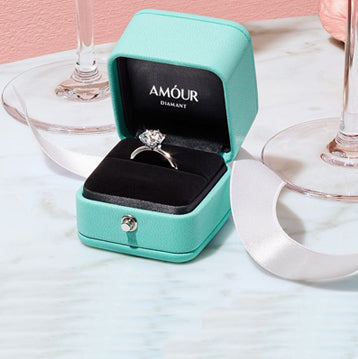White Gold or Platinum? Choosing the Right Metal for Your Engagement Ring

When it comes to choosing the metal for an engagement ring, white gold and platinum are two popular options. Both metals are durable and long-lasting, but they have different properties that make them suitable for different types of rings and budgets.
White Gold
White gold is an alloy of gold that is mixed with other metals, such as nickel or palladium, to give it a white color. It is a popular choice for engagement rings because it is less expensive than platinum and has a similar appearance. White gold is also hypoallergenic, making it a good choice for those with sensitive skin.
One of the downsides of white gold is that it can lose its shine over time, and it may require re-plating. The rhodium plating on white gold rings can wear off over time, revealing the yellowish color of the underlying metal. However, this can be easily fixed by getting it re-plated with rhodium, which is a relatively inexpensive process. It's important to note that the rhodium plating will wear off over time, and it is recommended to get it re-plated every 1-2 years, depending on the wear and tear of the ring.
Another downside of white gold is that it is a softer metal than platinum, which means it is more prone to scratches and dents. If the ring will be worn daily and exposed to harsh environments, white gold may not be the best choice.
Platinum
Platinum is a naturally white metal that is known for its durability, strength, and rarity. It is a popular choice for engagement rings because it is more durable than white gold and it will not lose its shine over time. Platinum is also a dense metal, which makes it a good choice for rings with larger diamonds or gemstones. The density of platinum makes it a more secure setting for the diamond and less likely to lose it.
One of the downsides of platinum is that it is a more expensive option than white gold. The price of platinum is usually 2-3 times higher than white gold, which can make it out of budget for some couples. Additionally, Platinum is a heavier metal, which can make it less comfortable to wear for some people.

Durability and Maintenance
When it comes to durability, platinum is the clear winner. As a naturally white metal, it does not require re-plating, and it is more resistant to scratches and dents. Platinum is also a denser metal, making it more secure for the diamond or other precious stones.
On the other hand, white gold requires re-plating every 1-2 years, and it is more prone to scratches and dents. Additionally, white gold is a softer metal, which makes it more prone to bending or warping over time.
Allergies
For people with sensitive skin, white gold is a better option than platinum. White gold is hypoallergenic, which means it is less likely to cause an allergic reaction. Platinum, on the other hand, contains trace amounts of nickel, which can cause an allergic reaction in some people.
Conclusion
When choosing the metal for an engagement ring, it is important to consider your budget, personal preferences, and lifestyle. White gold is a good choice for those on a budget who want a similar look to platinum, but it may require re-plating in the future. Platinum is a more expensive option, but it is more durable and long-lasting, and it will not lose its shine over time. Additionally it's important to consider the durability of the ring based on the lifestyle of the wearer, as well as any allergies or sensitivities the wearer may have. The choice of metal also depends on the color preference, whether you want the metal to be naturally white or re-platable. Both white gold and platinum can make beautiful engagement rings, but it is important to weigh the pros and cons of each metal and make an informed decision that fits your specific needs. Furthermore, it is always a good idea to consult with a jeweler to ensure that you are getting the best quality and value for your budget. With the right metal, an engagement ring can be a symbol of love and commitment that will last a lifetime.



































